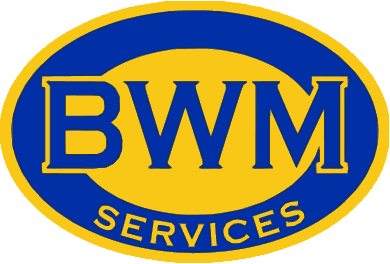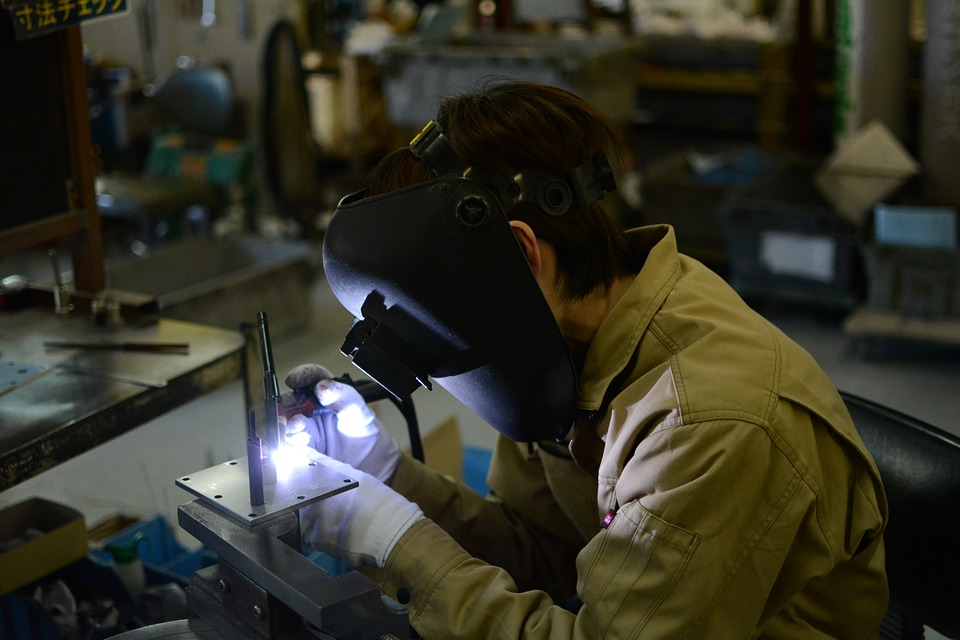An increased use of aluminum means the need to be able to weld the material with high quality. This article will focus on material preparation of aluminum prior to welding. Preparation of aluminum becomes a high priority when looking at the properties of this material that affect the quality of the welds, such as the high solubility of hydrogen in its molten state.
Material Storage
As soon as the material is subjected to oxygen, aluminum forms an oxide layer. The rate at which the oxide grows greatly depends on storage conditions such as temperature and relative humidity of the storage area. Aluminum oxide is porous and can become hydrated even when water is not in contact with the material. It is best to store aluminum indoors to avoid weather elements. However, in some industries, storing aluminum indoors is not practical and in some cases not possible. When storing aluminum outdoors, it should be stored vertically with space in between the sheets to allow rain water to flow freely off the plates and avoid wicking. In addition, any interleaving should be removed to avoid water pocketing in between the interleaving and the aluminum plate.
Thermal Cutting Processes
Plasma Arc Cutting
Plasma arc cutting is the most commonly used thermal cutting process for aluminum. It is extremely quick on thin materials and can cut up to 6-in. thick aluminum plate at slow cutting speeds. Achieving a high quality cut requires thickness and travel speeds to be set correctly. When the travel speed of cutting is faster than optimum, the quality of the cut can be sacrificed. Generally, air plasma cutting can be used for cutting material thicknesses up to ¼ in. When plasma cutting a plate thick than ¼ in., it is recommended to utilize argon or nitrogen as a plasma gas to increase cutting capabilities.
Plasma cutting can either be done manually or using a mechanized or automated cutting table. The downsides of plasma arc include high heat inputs that can cause microcracking at the cut interfaces. It is ideal practice to remove 1/8 in. of the material from the cut edge to discard any cracking that may have occurred. Additionally, the cut edge can have a kerf and slight roughness to it, and noise levels are high and may require hearing protection.
Laser Beam Cutting
Laser beam cutting technologies are also used to cut aluminum. The benefits of laser beam cutting include the ability to cut thin material without causing distortion, less heat-affected zone and kerf and cut surfaces are very smooth. One downside is the thickness of material that can be cut is limited to about 3/8 in. (~13 mm). Similar to plasma cutting, the laser cutting process can cause liquation cracking mainly in heat-treatable alloys. Laser cutting is also more expensive than plasma cutting, it is not a portable process and there is an increased amount of dross on the underside of the plate. Due to the high reflectivity of aluminum, high-power lasers are required for cutting. This can also decrease the life of the laser.
Mechanical Cutting
Mechanical cutting is extremely useful for the preparation of aluminum before welding. For the most part, the processes are extremely efficient and inexpensive. One thing that should be noted is the need for cutting lubricant is less than when cutting steels, but if it is used, make sure the oils are removed using the methods in the “Preparation of Aluminum before Welding” section.
High-Pressure Waterjet Cutting
Waterjet cutting uses high-pressure water with the addition of an abrasive garnet. Water pressures can reach up to 100 kilo-pounds per square inch (ksi) and the velocity of the water can reach speeds of Mach 3 or 2283 mph. Temperatures only reach 193°F, allowing the aluminum to be cut without causing liquation cracking like the thermal cut processes. This process can cut aluminum up to 9.25 in. thick. However, there are limitations. Cutting speeds are slower compared to plasma. For instance, travel speeds might be as slow as 3.8 in./min when cutting aluminum with the thickness of 1.5 in. Additionally, waterjet cutting systems are expensive and not portable.
Machining
Machining of weld preparations can be performed using various tools. Milling machines, bed planers and shapers are commonly used with carbide cutting tools. It is recommended that any machining be performed without any cutting lubricants.
Sawing
Band and circular saws both are commonly used to make weld preparations. Higher blade speeds and finer teeth are required than when cutting steel. Recommended blade surface speeds are 3400-4200 surface ft/min for carbide circular saws and 3500 surface ft/min for band saws when cutting aluminum. Band saw blades should have no more than four teeth per inch. If using circular saws, the cut quality can be good enough so that no further preparation is necessary. Band saws typically leave a coarse surface that must be sanded or ground.
Grinding and Sanding
All grinding and sanding discs utilize an organic binder to hold the abrasive material together. This can introduce hydrocarbons into your weld causing porosity. Some manufacturers specify that the grinding or sanding disc is made specifically for aluminum, which simply means the abrasive used is most effective at removing aluminum. It is recommended to do the following simple destructive test to determine if a specific grinding or sanding disc is suitable for preparation of aluminum before welding.
- Weld a 6-12 in. fillet weld using clean material.
- Clamp the welded plate to a table and use a hammer to fold the weld face onto itself.
- Check the fracture surface of the weld to see if it exhibits porosity.
- Once you are sure that under normal conditions the welding process does not create porosity, use the grinding or sanding disc you would like to test to remove some aluminum from the area you will be welding to make the fillet weld.
- Repeat steps 1 through 3.
Shearing
Shearing is extremely useful to cut sheets or plates to sizes, but the edge quality is rarely acceptable for welding. It is relatively rough and has many crevices that can trap oils, greases, etc. It is recommended that the edge be smoothed by machining, grinding or sanding after shearing.
Routers and Carbide Burns
Routers can be utilized for repairs and back-gouging. Caution must be taken for a few reasons; if using an air-powered router, make sure that there is a dryer on the line to prevent moisture from getting on the workpiece. Ensure that when using for repair work or back-gouging, the material is removed to sound metal to avoid weld defects.
Preparation of Aluminum before Welding
Oil and Grease
Aluminum has a high hydrogen solubility in its molten state, so it is recommended to remove any oil or grease from the area of welding to reduce or eliminate the possibility of porosity. Removal of oil and grease can be performed in several ways; for instance, wiping a clean rag saturated with a degreasing solvent. This method is extremely effective. When selecting a solvent, it is ideal to have a high threshold limit value (TLV) and a low flash point. For both of these reasons, it is best to consult with your environmental and safety representative.
Next, mild alkaline solutions make good degreasers. The part to be degreased can be sprayed with these solutions or dipped into a tank containing them. Since such cleaners are generally water based, it is important to thoroughly rinse and dry the part after degreasing.
Lastly, many suppliers sell acid-based cleaning solutions for cleaning aluminum. These are typically effective and also can remove excessive oxides, but all are acidic and some contain hydrofluoric acid. Caution for use and dispose is required. Again, the piece must be thoroughly rinsed and dried before welding.
Whichever method you use, it is important to degrease the part to be welded before performing any of the oxide removal procedures outlined below. Otherwise the oil and grease will be spread by the oxide removal and will be difficult to remove.
Oxide Removal
Removing the oxide layer is important before welding aluminum for a couple of different reasons. Aluminum oxide melts at a temperature significantly higher than that of aluminum. If welding on oxide that is excessive in thickness, oxide entrapment in the weld can occur. The oxide is porous and it tends to draw in moisture in humid environments, leading to porosity in the weld if the material is not properly prepared for welding.
Oxide remove can be performed in several ways as well. The most common is to use a stainless steel wire brush. The brush should be clean and not previously used on materials other than aluminum. The brush should be relatively flexible and utilized with light pressure to avoid unnecessarily roughening of the surface.
Oxide removal can also be performed by immersing the part in a strong alkaline solution, but these solutions are very corrosive and can etch the surface of aluminum. As a result, extreme care must be used.
In some industries, particularly aerospace, final oxide removal is performed just before the joint is fit together by mechanically removing the oxide using a steel scraper (identical to those used in woodworking) or by draw filing. Once the cleaning is performed, the joint is fit together as soon as possible. These are extremely effective methods for oxide removal, but they are time consuming, costly and primarily used in industries where the demand for extremely high quality overrides the additional cost.
Using these guidelines will greatly increase the quality of aluminum welds for those who are new to welding aluminum, or for those who are having difficulty producing consistent, high-quality aluminum welds.
Source: aws.org


